
An immense truck snake stretches from the Peñas Blancas border to the town of Sonzapote de La Cruz, about 13 kilometers from the migratory post with Nicaragua. It occupies the entire descent lane and then any vehicle descending must transit against traffic, parking lights, whistle from time to time, in order to continue to the official border post, which Nicaragua keeps closed.
It’s 7:37 a.m. Thursday, March 21. Blanca Rostrán, 29, leaves her house located in the community Los Vertientes of Sonzapote. She carries a tower of sandwiches, an apron, and a sweet smile with braces. “It’s because almost all of them are known.” A reason that she and her family consider enough to collect money and give them food, water, juice, and coffee. Just today they made 330 ham and butter sandwiches.
Luis Recino and Ángel Ruano grab their sandwich with regret and thank her three times. They are Guatemalan and arrived last night at the line that will one day take them back to their country. They say that when they entered from the north, they waited eight days for Costa Rica to test them for COVID-19. They managed to pass just before Nicaragua closed the passage completely, a protest against the Costa Rican Ministry of Health order to prevent the entry of transporters beyond the border.
Peñas Blancas was already a very problematic border post, says the mayor of La Cruz, Alonso Alan. As he grew up in Las Vueltas, right there between the center of La Cruz and Peñas Blancas, he says the community has always been used to the fact that “it is basically an area with few services to stay for a whole day”. According to him, the constant lines, the delays in customs and the poor communication and coordination of actions between Costa Rica and Nicaragua contributed to that. “Suddenly, the Nicaraguan side of the border decides to close and what, we are stuck with everything,” he will tell us later in his office.
There are hundreds of other carriers stranded at the border. Some carry merchandise from Costa Rica, others brought it in and return empty, and many are here only in transit. In the search for answers, we turn to them: we wonder what it is like to be away from your country, stranded for days without drinking water, food, or sanitary services, and in the midst of a global pandemic in which you are required to be more alone than ever.
(After this story was published in Spanish, the Emergency National Committee announced they installed some sanitary cabins, wastebasket, and lavatories so they can keep showering)
The first thing we notice is the contrast between the information that reaches them and the one obtained by the population through press conferences. The bad guy in the movie, from their point of view, is the government.
“The government … of Nicaragua?” we asked them.
“No, the Costa Rican government that does not want any Central American driver to enter. That at first they told us that we were heroes because we brought the food they need, and now we are a bomb,” says Luis, who has his eyes sunk in deep circles and wears a Corona beer t-shirt.
Luis and Ángel’s perspective resonates with other drivers. “The problem itself is the laws of your beloved country, which does not want to let us work,” Guatemalan Abilio González will tell us later.
“In all the countries of Central America, except Costa Rica, they only put the distance thermometer. They fill out a sheet for you and that’s it,” tells Julio César Martínez, also Guatemalan, about 500 meters north of Blanca’s house.
The explanation, however, is much more complex than that: it begins precisely with the story of a driver, who entered the country five weeks ago through Peñas Blancas, unloaded products in a warehouse in Liberia, and triggered the spike in infections that Guanacaste is having right now.
Until Tuesday, May 19, that carrier was the cause –directly and indirectly– of at least 18 positive cases, according to the report of the Minister of Health, Daniel Salas. It is a chain of infections that spans La Cruz, Liberia, Cañas, Bagaces and Abangares.
That day, 38 infections across the country came from infected drivers who entered when traffic was less regulated.
The measures evolved little by little after that first case. First, the country began to reject the entry of foreign truck drivers with symptoms and to test all the others at the border posts. But in the first days, when only the samples were taken and they were allowed to enter the country, seven were positive.
To avoid possible contagions, on May 8 the Ministry of Health established that carriers should wait for the result at the border, before entering the country, and that generated the first slowdown in trade. Some spent up to five days at the border, till they were tested and waited for the result.
“We started to congest Peñas Blancas, and that congestion was still impractical: if a carrier had the test applied at this time, he continued to live there for a couple more days with all the other carriers, with the people who work in Peñas Blancas, with few controls, ” remembers the mayor of La Cruz, Alonso Alan. “Who says that in the two days they lived together, he couldn’t have infected others?” asked Alan.
Finally, the Minister of Security, Michael Soto, announced the protocol that generated the anger of the Nicaraguan government: foreign carriers would only enter to unhook their truck in the border area so that another Costa Rican carrier would take it away.
“Costa Rican authorities began to impose unilaterally, there was no call to discuss the issue, and resulted in the closure of the border,” Ortega insisted in a conference on Monday, May 18.
Beyond the fight that we perceive between carriers and the government, the problem affects us all: according to the Minister of Foreign Trade, Dyalá Jiménez, 20% of national exports are made to Central America. In fact, this region is the second most important trading partner for Costa Rica, after North America. Shortages are a danger to the entire area.
Six kilometers, six days. “We are going through unhealthiness”
The Roldán family’s sandwiches reach Las Vueltas school, about six kilometers from the border.
Right here, Nicaraguan Eddie Lacayo, 27, stretches out a hammock under the trailer and lies down to watch his cell phone. It’s 10:34 a. m. He has been working on the road for four or five years, but only two months with the owner of this truck. He says his boss is the one who sends them food, but if not, they improvise with a rice cooker and things they buy at the supermarket.
The problem with going to the grocery store, his colleagues say, is that at any moment they open the border and they get thrown away. Since they are always alone, they cannot leave the truck unattended: they are not only stuck at the border, but forced to stay put. Eddie buys buckets of water for a thousand colones and bathes in his trailer.
Some neighbors along the way lend or rent them toilets and showers from their homes. The local government of La Cruz has also distributed drinking water and some food. “We are already planning to go again this weekend,” says the mayor of La Cruz. “But the vice president said it very well: it is unsustainable for us.”
As the line progresses, the temperature increases and the drivers start getting rid of what suffocates them most. Some roll up their shirt and hold it with their stomach. Others prefer to take it off, or perhaps never put it on. Very few wear a mask or protective equipment.
Juan Carlos Escobar, dark skinned, bulky and with puffy eyes, appears from the top window of an orange truck. He’s been here about six days. He has the illusion that food will arrive today, although he does not have clear how.
“The company is quite good, it is in El Salvador, they told us, they would send us things to eat. And that they would send them today. This day. So they coordinated. I think they are going to send it with someone from Nicaragua.”
The drivers we interviewed at the border mostly work for a company or for the owner of several transport units. They are only the last link in the chain of sanitary, scientific, political and logistical decisions.
“I don’t know if these countries [Nicaragua and Costa Rica] have a rivalry or what, but if you don’t want to let the other one enter here, that’s fine, but let the people of Guatemala, Honduras, and El Salvador leave that we have nothing to do with this, we are just passing through. This has already gotten out of control, there are no more profits, it is no longer useful, we are going through unhealthiness,” complains Juan Carlos.
Trucks are usually the kings of the road. The ones that blow past Route 27, the ones that any fairly sensible driver would have at least a little respect for. Perhaps that is why it feels so disconcerting to hear their drivers say they are not worth anything right now, that they are waiting for someone to give them food, or that they are trying to avoid going to the bathroom too much, so they do not spend the 500 colones they are charged when they are lucky to have one nearby.
“We have to follow the line, and if it moves, here we go, that is the instruction.” They work like this, at the instruction of someone else, a superior who in most cases is at home, with his family.
The director of the National Chamber of Cargo Transportation (Canatrac), Francisco Quirós, tells us by phone that he knows the leaders are at home, protecting themselves from COVID-19, while the carriers are there under the sun and water. “It is very easy for the leaders to ask them to stay there. That is why we hurry with a proposal to the government,” he explains.
The new proposal is for foreign carriers to drop the cargo in a fiscal warehouse, monitored at all times through a GPS, and to be collected there by Costa Rican carriers. At those same points, Costa Ricans leave the merchandise for the carriers to collect and take it to the destination country. At press time, Panama had started operating under this proposal, but Nicaragua had not yet accepted it. Meanwhile, Luis asked us via WhatsApp: “Ma’am, and do you have any idea if anything is resolved yet?”.
10% after expenses
The truck snake turns into a two-headed monster, about five kilometers before reaching the border. The line splits and the trucks line up side by side. So when we say that there are 13 kilometers of trucks, it’s actually more like 17 kilometers if it were a single line. The wait increases.
Guatemalans Abilio González, Luis Mijangos and Aroldo Gutiérrez are among the first in line. They have been here for ten days and are already rocking in their hammocks as if in autopilot. By 11 a.m. the temperature is already above 30 degrees Celsius.
“How much do you estimate you are losing?” we asked them.
“Oh, ma’am. I think we’re going to lose even our wife here! When we get back, not even the dog will want us in the house,” says Abilio.
Luis drags a bucket for one of us to sit down. “Excuse me for not bringing you a stool, but we don’t have any.”
The three of them explain how the transportation business works for a driver or company employee: those who do not own a truck earn approximately 10% of the total amount paid by the client, per trip. The boss gets between 65% and 70%, and the rest goes in diesel and travel expenses.
Partly because of this they are totally against leaving their merchandise at the border and returning to their country of origin. “The one who will keep the profit is the carrier that takes things from here,” they complain bitterly. They also oppose it because they usually bring goods here and return loaded, thus managing to get an extra for their earnings.
Quirós, from Canatrac, assures that they should not have losses but rather gains, because they will have to travel fewer distances. Still, he accepts that communication with carriers is poor: what the business leaders know is not even remotely close to what the drivers in the area believe.
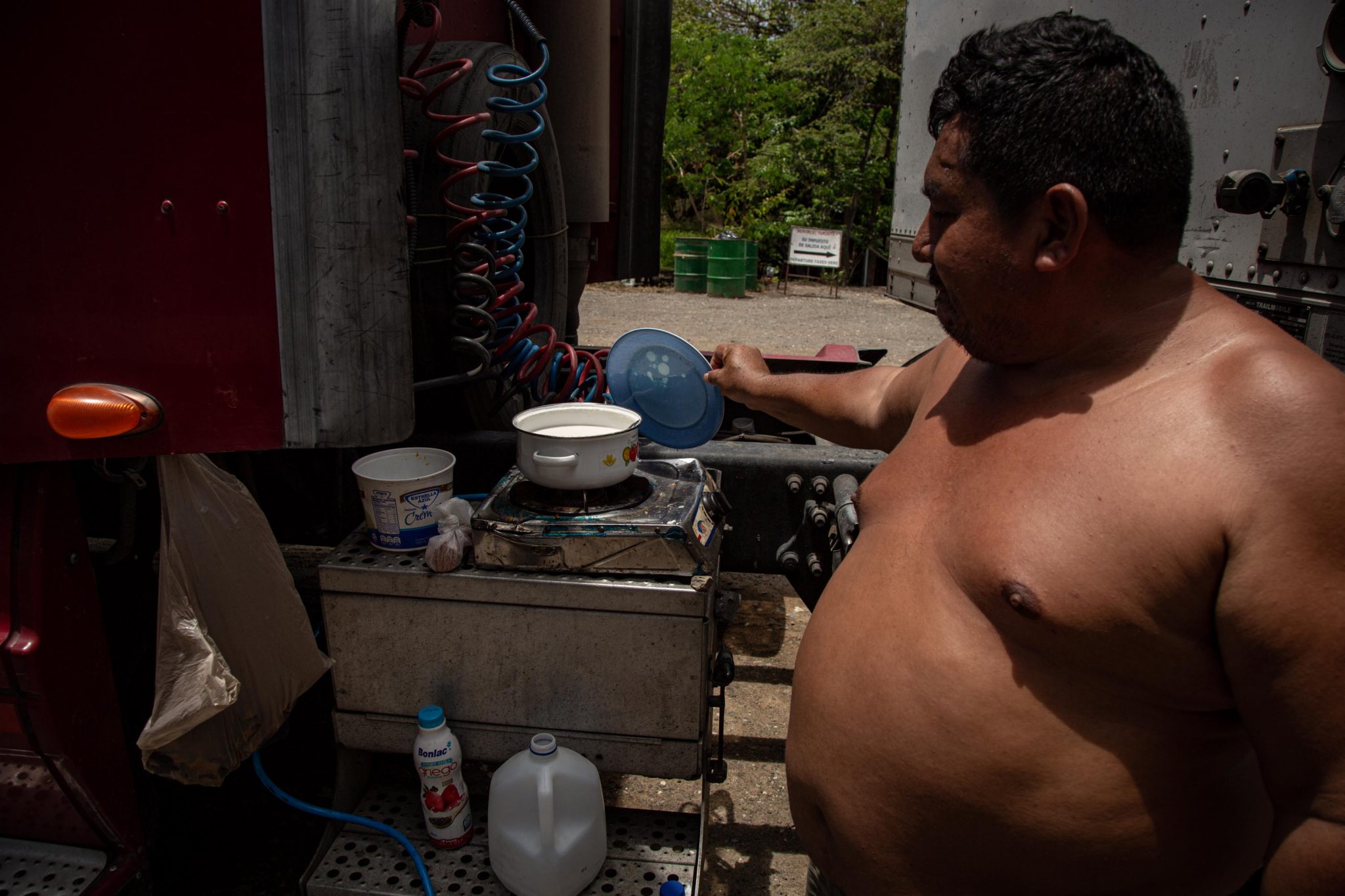
Abilio González cocinó arroz con leche para el desayuno. El agua para cocinar la traen en baldes de un tubo con agua pública que está a unos cuantos metros de aquí, cerca del puesto migratorio con Nicaragua. Foto: César Arroyo.
“And are you not afraid to get sick?” we asked the guys. Abilio says at once not. “I must die of something.” Luis and Aroldo say they are terrified of going home sick and making their family sick, too.
In terms of money, there will be nothing left on this trip. But anyway, when we ask them if they have a kitchen, they look at us with compassion and offer us from cooked for lunch earlier in the morning, in a camping stove that they put on the toolbox of the header trailer. “If someone wants [food], then we give it to them, because here we are all to help us.”


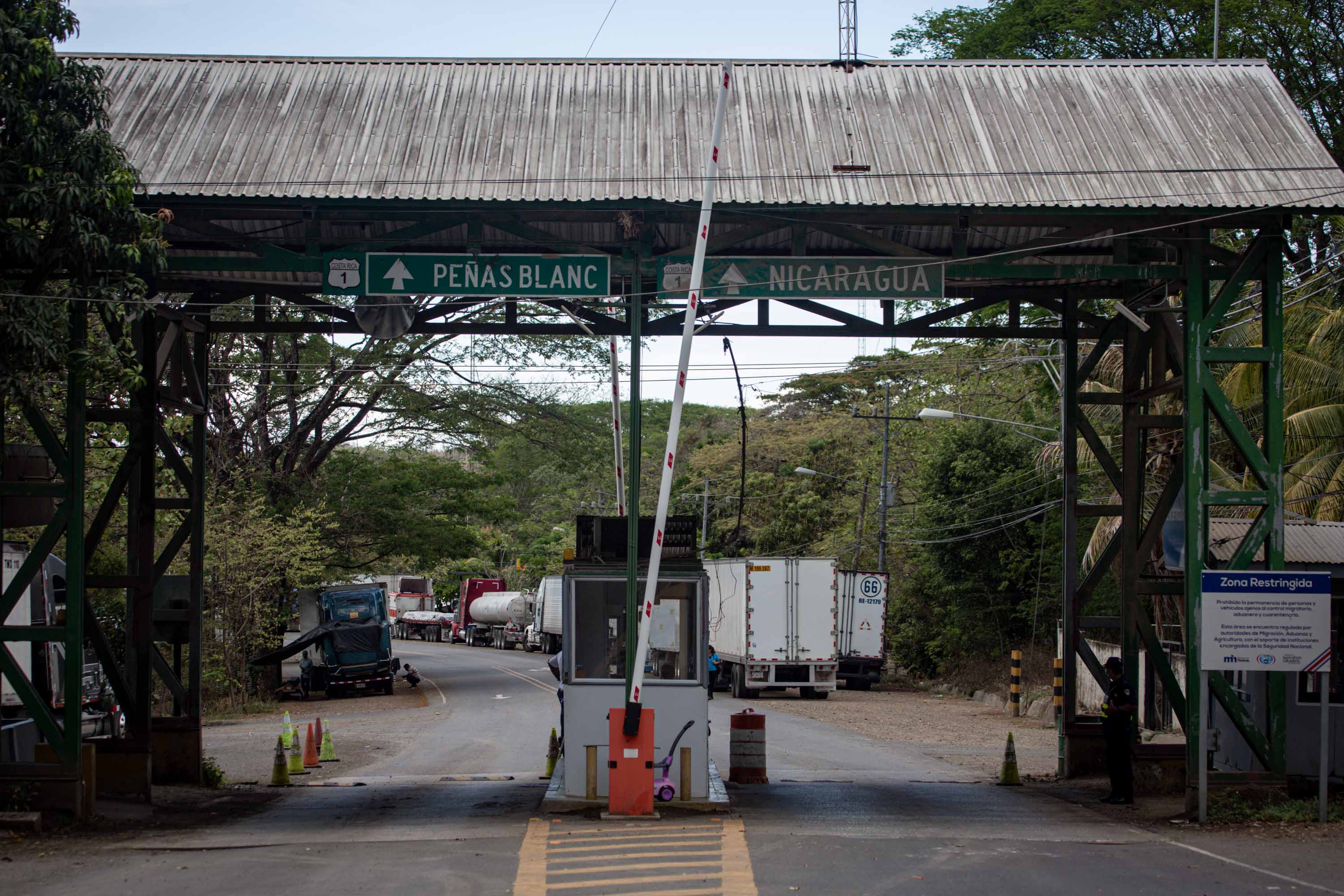
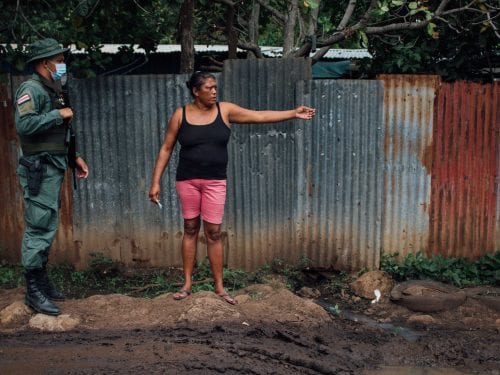
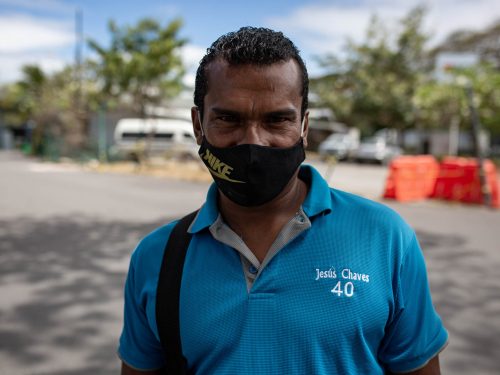
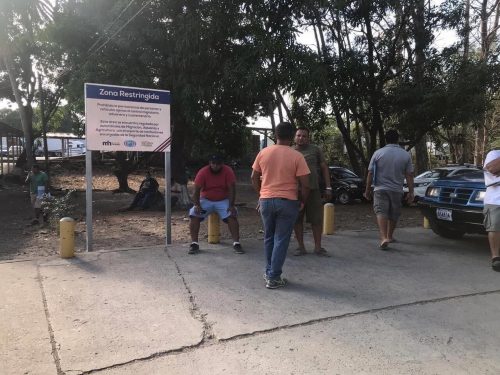

Comments